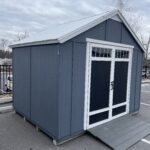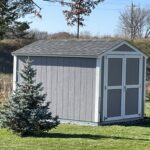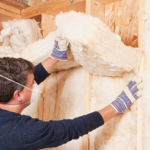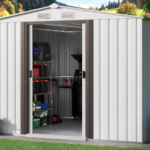I’ve been a member of Home Owner Associations (HOAs) and have dealt with them when building sheds, both for myself but also for customers. The presence of an HOA definitely adds a step to putting up a nice shed in your yard.
HOAs are known for having strict regulations and guidelines, and sheds are no exception. Shed owners must adhere to these rules to avoid penalties or even having their shed removed. Some HOAs prohibit sheds altogether, and toward the end of this piece I will talk about what to do in that situation.
HOA rules regarding sheds can vary from community to community, but they often cover aspects such as size, placement, and appearance. Some HOAs may require sheds to be a certain distance from property lines or have specific colors and materials. It is important for shed owners to familiarize themselves with their HOA’s rules to avoid any violations.
While HOA rules may seem restrictive, they are in place to maintain the aesthetic and safety of the community. Shed owners should work with their HOA to ensure that their shed meets the guidelines while still serving their needs. Every HOA is different, but the learnings below should apply across the board.
Purpose of HOA Shed Regulations
Homeowners’ associations (HOAs) often have rules and regulations regarding the construction and placement of sheds on their properties. These regulations serve several purposes, including:
Maintaining Aesthetics
HOAs often have strict guidelines for maintaining the overall appearance of the neighborhood. Sheds that are poorly constructed or placed in unsightly

locations can detract from the overall beauty of the community. By regulating the construction, look, and placement of sheds, HOAs can ensure that the neighborhood maintains its aesthetic appeal.
Ensuring Safety
Sheds can pose safety risks if they are not constructed properly or are placed in hazardous locations. HOAs may require that sheds meet certain safety standards to prevent accidents and injuries. They might also have strict rules on the upkeep you need to do to a shed, to prevent the shed from becoming dilapidated. This should not be a problem, any shed owner should be keeping it in excellent shape!
Protecting Property Values
The presence of sheds can sometimes negatively impact property values, especially if has a look and feel that is not in keeping with the neighborhood. At the same time, an attractive and functional shed can improve property values. HOAs may regulate the construction and placement of sheds to ensure that they do not negatively affect the value of neighboring properties.
Common Restrictions
There are several common restrictions to be aware of regarding sheds and HOAs. These restrictions are put in place to ensure that the sheds built in the neighborhood are safe, aesthetically pleasing, and in compliance with local zoning and building codes.
Approval Process
One of the most common restrictions that homeowners face when building a shed in an HOA neighborhood is the application and approval process. Expect to build a couple extra weeks in to the building process in order to get all the approvals you need before beginning construction. Homeowners associations typically require that plans, drawings, and pictures of the proposed shed be submitted for approval before construction can begin. This is to ensure that the shed meets all of the necessary requirements and is in compliance with local zoning and building codes. Many times, the steps you need to go through with your HOA are quite similar to what you would need to do to get a city permit for a shed.
Total Footprint
HOA rules often have maximum dimensions for sheds, with the “total footprint” being a primary concern. This typically refers to the amount of space that the

shed takes up in relation to the lot size. For example, many HOAs only allow sheds to cover a maximum of 1 percent of the lot, or they want a shed to never be more than 10×12 in order to not have it appear that there are outbuildings going up everywhere.
If all you are looking for is a nice garden or lawnmower shed, you should have a good chance of approval. If you want another place to park a 3rd car, it will be harder.
Maximum Height
Height is a factor that most HOAs closely monitor. This includes not only the height of the roof but also the maximum height of the walls. Homeowners associations may have specific regulations in place regarding the maximum height of sheds. The reason they do this is to prevent someone from building what amounts to a backyard garage in an neighborhood that is not intended for that kind of use.
Positioning
It is pretty common for the HOA to set restrictions on where they can place their new shed. HOAs may limit the visibility of the shed from the street or require a specific distance from the property line. It is important to find a spot that is both convenient and in compliance with the rules, as moving a shed after it is built can be difficult and costly. Assume that you cannot set the shed right against the line to your neighbor’s property, as this will affect their views.
The Look
This one is really common. HOAs often regulate the materials used for shed siding, roofing, and even the colors used on sheds. Homeowners may be required to use specific materials or colors that match the overall aesthetic of the neighborhood, or even materials that match their house. Yes, it can add cost to do this, but the end result will be a higher overall property value. Most buyers want a neighborhood that blends well and has an overall attractive look.

Quality
Finally, HOAs may require that sheds have certain quality elements to be sure they are not just run down buildings in the making. The HOA might want you to have a solid floor, ruling out prefabricated sheds that rely on dirt or gravel as a base. They might require a certain type of shed anchoring for safety in big storms, or might even want the construction of walls to have certain specifications (like studs every 16 inches.)
Navigating HOA Shed Approval Process
If you’re planning to add a shed to your property in an HOA community, there are certain rules and regulations that you probably need to follow. The HOA very likely has a set of guidelines that dictate the size, design, and placement of sheds. Here’s a guide to help you navigate the HOA shed approval process.
Pre-Application Considerations
Let’s say you can do a shed but you need to have an application approved first. Follow the process closely to make life easier for yourself.
Application Steps
Once you’ve done your research and are ready to apply for a shed, you’ll need to follow these steps:
- Fill out an application form: The HOA should provide you with an application form that you’ll need to fill out. Make sure you provide all the necessary information, including the size and design of the shed.

- Submit your application: Once you’ve completed the application, submit it to the HOA. You may need to pay a fee to process the application.
- Wait for approval: The HOA will review your application and let you know if it’s been approved. If it’s not approved, they’ll let you know what changes you need to make.
Post-Approval Requirements
Once your shed has been approved, there are a few things you need to keep in mind:
- Follow the rules: Make sure you follow all the HOA rules and regulations regarding the shed. This includes the size, design, and placement of the shed.
- Maintain the shed: Keep the shed in good condition and make any necessary repairs.
- Renew your approval: Some HOAs require you to renew your shed approval every few years. Make sure you keep up with any renewal requirements.
What to do if your HOA Doesn’t allow sheds
Now let’s imagine that your HOA has a “No Shed” rule. What do you do?
I would talk to your HOA board and express your desire to alter the No Shed rule. Be respectful and polite in your approach, and explain how a shed can make the community more livable by reducing rubbish outdoors and improving property values.
It’s important to note that your HOA board may have valid reasons for not allowing sheds, such as city or state regulations. If this is the case, ask if there are any exceptions or variances that can be made. Some HOAs may allow sheds if they meet certain criteria, such as being a certain size or style.
If your HOA board is unwilling to change the rule based on your request, you may want to consider gathering support from other homeowners in the community. This can be done through a petition or by speaking at HOA meetings. By showing that there is a demand for sheds in the community, your HOA board may be more willing to reconsider the rule.
Something I’ve done before that seemed to help was having a nicely-rendered drawing of what the shed I wanted to build would look like on the property, factoring in the neighbors houses and yards. When people see it on paper, and realize it will be attractive, they might get on board. In this case, the shed was going to be set on an area where the grass never grew well anyway, removing one of the HOAs other headaches.












